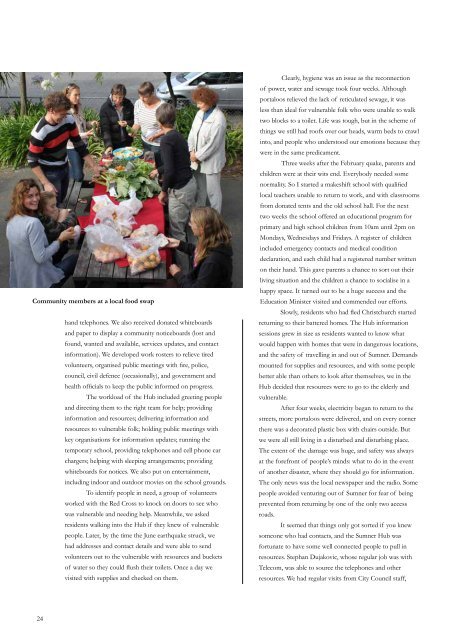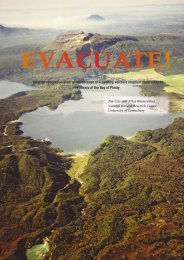Download Tephra Volume 23 (PDF, 1.33MB) - Ministry of Civil ...
Download Tephra Volume 23 (PDF, 1.33MB) - Ministry of Civil ...
Download Tephra Volume 23 (PDF, 1.33MB) - Ministry of Civil ...
You also want an ePaper? Increase the reach of your titles
YUMPU automatically turns print PDFs into web optimized ePapers that Google loves.
Community members at a local food swap<br />
hand telephones. We also received donated whiteboards<br />
and paper to display a community noticeboards (lost and<br />
found, wanted and available, services updates, and contact<br />
information). We developed work rosters to relieve tired<br />
volunteers, organised public meetings with fire, police,<br />
council, civil defence (occasionally), and government and<br />
health <strong>of</strong>ficials to keep the public informed on progress.<br />
The workload <strong>of</strong> the Hub included greeting people<br />
and directing them to the right team for help; providing<br />
information and resources; delivering information and<br />
resources to vulnerable folk; holding public meetings with<br />
key organisations for information updates; running the<br />
temporary school, providing telephones and cell phone car<br />
chargers; helping with sleeping arrangements; providing<br />
whiteboards for notices. We also put on entertainment,<br />
including indoor and outdoor movies on the school grounds.<br />
To identify people in need, a group <strong>of</strong> volunteers<br />
worked with the Red Cross to knock on doors to see who<br />
was vulnerable and needing help. Meanwhile, we asked<br />
residents walking into the Hub if they knew <strong>of</strong> vulnerable<br />
people. Later, by the time the June earthquake struck, we<br />
had addresses and contact details and were able to send<br />
volunteers out to the vulnerable with resources and buckets<br />
<strong>of</strong> water so they could flush their toilets. Once a day we<br />
visited with supplies and checked on them.<br />
Clearly, hygiene was an issue as the reconnection<br />
<strong>of</strong> power, water and sewage took four weeks. Although<br />
portaloos relieved the lack <strong>of</strong> reticulated sewage, it was<br />
less than ideal for vulnerable folk who were unable to walk<br />
two blocks to a toilet. Life was tough, but in the scheme <strong>of</strong><br />
things we still had ro<strong>of</strong>s over our heads, warm beds to crawl<br />
into, and people who understood our emotions because they<br />
were in the same predicament.<br />
Three weeks after the February quake, parents and<br />
children were at their wits end. Everybody needed some<br />
normality. So I started a makeshift school with qualified<br />
local teachers unable to return to work, and with classrooms<br />
from donated tents and the old school hall. For the next<br />
two weeks the school <strong>of</strong>fered an educational program for<br />
primary and high school children from 10am until 2pm on<br />
Mondays, Wednesdays and Fridays. A register <strong>of</strong> children<br />
included emergency contacts and medical condition<br />
declaration, and each child had a registered number written<br />
on their hand. This gave parents a chance to sort out their<br />
living situation and the children a chance to socialise in a<br />
happy space. It turned out to be a huge success and the<br />
Education Minister visited and commended our efforts.<br />
Slowly, residents who had fled Christchurch started<br />
returning to their battered homes. The Hub information<br />
sessions grew in size as residents wanted to know what<br />
would happen with homes that were in dangerous locations,<br />
and the safety <strong>of</strong> travelling in and out <strong>of</strong> Sumner. Demands<br />
mounted for supplies and resources, and with some people<br />
better able than others to look after themselves, we in the<br />
Hub decided that resources were to go to the elderly and<br />
vulnerable.<br />
After four weeks, electricity began to return to the<br />
streets, more portaloos were delivered, and on every corner<br />
there was a decorated plastic box with chairs outside. But<br />
we were all still living in a disturbed and disturbing place.<br />
The extent <strong>of</strong> the damage was huge, and safety was always<br />
at the forefront <strong>of</strong> people’s minds: what to do in the event<br />
<strong>of</strong> another disaster, where they should go for information.<br />
The only news was the local newspaper and the radio. Some<br />
people avoided venturing out <strong>of</strong> Sumner for fear <strong>of</strong> being<br />
prevented from returning by one <strong>of</strong> the only two access<br />
roads.<br />
It seemed that things only got sorted if you knew<br />
someone who had contacts, and the Sumner Hub was<br />
fortunate to have some well connected people to pull in<br />
resources. Stephan Dujakovic, whose regular job was with<br />
Telecom, was able to source the telephones and other<br />
resources. We had regular visits from City Council staff,<br />
24

















